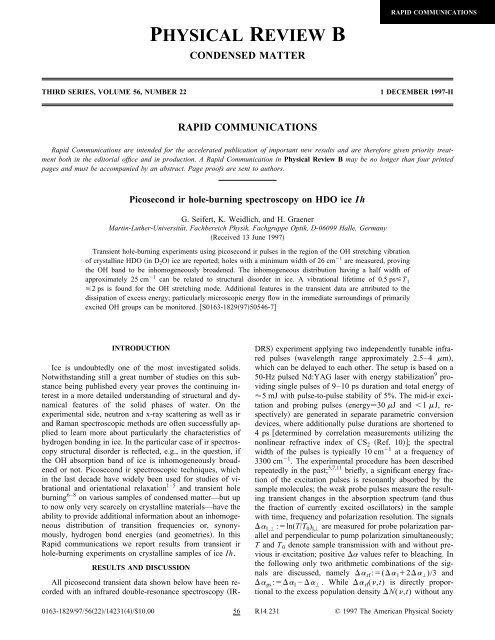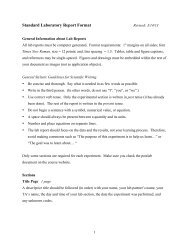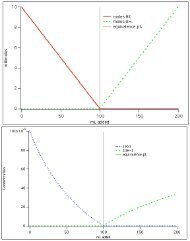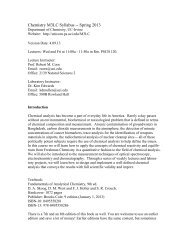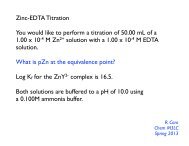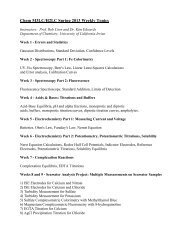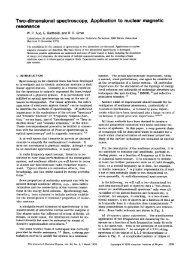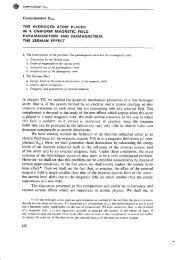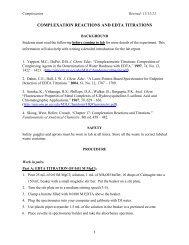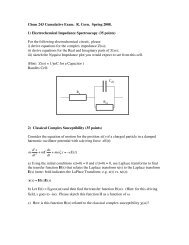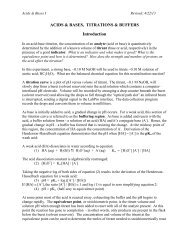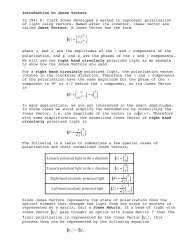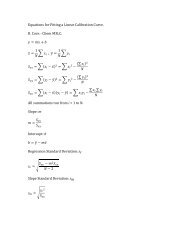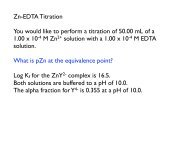physical review b - APS Link Manager - American Physical Society
physical review b - APS Link Manager - American Physical Society
physical review b - APS Link Manager - American Physical Society
Create successful ePaper yourself
Turn your PDF publications into a flip-book with our unique Google optimized e-Paper software.
RAPID COMMUNICATIONS56 PICOSECOND ir HOLE-BURNING SPECTROSCOPY ON ...R14 233FIG. 3. Time dependence of transient spectra of ps solidcircles and rf open squares for excitation at 3300 cm 1 ; increasingdelay time from bottom to top t D 3, 1, 5, and 8 ps.excited state absorption from first to higher vibrational energylevels with large anharmonic redshift about 300 cm 1 and broadening FWHM 250 cm 1 . The vibrational lifetimeof the OH stretch of HDO/D 2 O ice cannot be determineddirectly from the current time resolved data, but anupper limit of 2 ps—representing the time resolution of theexperimental system—can be given. A lower limit can beobtained from the minimum linewidth of bleaching; thisquestion and the characteristics of the observed induced absorptionswill be discussed below.The notably smaller bandwidth of bleaching compared tothe conventional absorption band strongly suggests that atransient vibrational hole is observed, or, in other words, theOH band in ice is inhomogeneously broadened, the width ofthe inhomogeneous distribution being of the same order asthe homogeneous linewidth. This interpretation is proven bythe data of Fig. 2, which illustrate the effect of tuning theexcitation frequency off resonance any other experimentalsettings are kept unchanged with respect to the situation inFig. 1. As is easily seen for three quite different excitationfrequencies, i.e., pu 3260 cm 1 data points represented bystars, pu 3300 cm 1 open squares, pu 3340 cm 1solid circles, the peak of the transient hole shifts accordingto the pump frequency, but only for an amount of less than10 cm 1 in either direction despite the rather large shift ofthe excitation. While this general trend is a typical behaviorfor transient hole burning, the rather small shift of the hole inaccordance with pump detuning is a special consequence ofor, vice versa, a strong hint for the presence of a quite narrowinhomogeneous distribution. 14 In addition, this finding allowsus to exclude coherent artifacts, which could only arisedirectly at the excitation frequency. The relatively large amplitudesof the given data with off resonant pumping comparedto central excitation suggest a significant degree ofsaturation in the experiments.The main features of time development in the bleachingregion and additional information about the dissipation ofrelaxed vibrational energy can be recognized looking at thetransient spectra of both ps solid circles and rf opensquares given in Fig. 3 for four different delay times t D 3, 1, 5, and 8 ps increasing from bottom to top; the excitationfrequency is pu 3300 cm 1 in each case. At thetwo early delay positions both signals exhibit very similarprofiles; namely, an intense and rather narrow hole at thepump frequency with a slight asymmetry, which is best seenat t D 1 ps as bleaching at the low-frequency wing, but inducedabsorption at the high-frequency side of the band. Forlater delay positions significant differences arise: ps doesnot change its principal shape, only its amplitude decreasesfor delay times 10 ps it has returned to zero within experimentalaccuracy and the hole is slightly broadened withincreasing delay time. The ‘‘rotation free’’ signal rf howeverevolves to a very different contour bleaching below3300 cm 1 , induced absorption above, which finally remainsconstant for the whole delay range of the experiment,i.e., up to t D 3 ns. This long time spectrum in accordancewith previous work on hydrogen bonded systems 5,7,14 is attributedto local temperature rise of the order of 10 K in theexcitation volume after thermalization of the vibrational energyshifting the hydrogen bond distribution on average tolower energies, and thus the OH absorption band to higherfrequencies. As all HDO molecules in the probed volume areinvolved, this is an isotropic effect seen only in rf .For the early delay times, the amplitude ratio of ps and rf reveals a molecular reorientation time rot T 1 confirmingthe expectation that in a crystalline sample no fast orientationalmotion should be present. The minimum FWHM of26 cm 1 found at t D 3 ps can be used to get a lowerlimit for both energy relaxation (T 1 ) and dephasing (T 2 ):calculating an effective relaxation time (c) 1 comprisingboth processes yields 400 fs, even if the finitewidth of pump and probe pulses is not accounted for. So 400fs is clearly a lower limit for vibrational lifetime and dephasingof the OH stretching mode in crystalline HDO ice. Regardingthe width of the conventional ir absorption band, ahalf width of the inhomogeneous distribution of approximately25 cm 1 can be estimated. Due to hole asymmetryand probable saturation effects no additional informationabout, e.g., spectral diffusion can be drawn from the observedincrease of hole width.Turning to a microscopic view of energy dissipation arather plausible explanation for the hole asymmetry seen in ps is suggested by the above findings: in a first step afterdeexcitation of an OH stretching vibration the relaxed energywill still be located in the immediate surroundings of theoriginally excited molecule, thereby modifying hydrogenbonding only in the small volume directly around this molecule;most likely the bonds will on average be weakenedlike in the case of temperature rising, even if the notion‘‘temperature’’ is not appropriate for the molecular scale.The next neighbors of an HDO molecule however are withhigh probability only D 2 O molecules, because at the givenconcentration of 0.5 mol/1 HDO on average only roughly 1HDO molecule is found within 100 D 2 O molecules or, synonymously,the average distance between next neighbors islarger by nearly a factor of 5 for HDO compared to D 2 O asis easily seen taking simply the cubic roots of concentrations.So effects in the transient spectra in the OH spectral
RAPID COMMUNICATIONSR14 234 G. SEIFERT, K. WEIDLICH, AND H. GRAENER56region corresponding to this situation immediately after relaxationof an individual quantum of vibrational energy canonly be due to the primarily excited HDO molecule. Correspondingtransmission changes are likely to be similar to thebulk thermal effect with regard to its principal spectral shapebleaching at the low-frequency side of the band, inducedabsorption at the high frequency side, but as an HDO moleculein the ice lattice can hardly change its orientation, theorientational information of the excitation process will beconserved, i.e., the changes must be anisotropic and can thusbe seen also in ps . With ongoing dissipation the relaxedenergy will be distributed over a larger volume graduallyaffecting more HDO molecules with varying orientation andof course smaller amount of energy per individual OH group,so that finally the orientational information is lost and thespectral changes approach the isotropic thermal bulk effect.It is interesting to estimate local energy densities at differentstages of the discussed thermalization process: in an individualearly situation, where only one HDO molecule and itsfour next neighbors in the tetrahedral geometry are affectedby the energy of one relaxed vibrational quantum, the localenergy density is equivalent to a temperature rise by about200 K calculated simply from molecular density and specificheat; macroscopically, however, the situation of thelong time spectrum, i.e., homogeneous distribution of thewhole pump energy in the excitation volume, corresponds toa temperature increase of only 10 K assuming previoussingle excitation of each HDO molecule.Sticking to this interpretation the hole asymmetry can beexplained simply by overlap of the prominent effect, the actualnonequilibrium vibrational population, with the anisotropiceffects of energy dissipation; as to the short vibrationallifetime—compared to the applied pulse duration—no delaybetween these two contributions should be measurable. Thissuggestion is proved by the fact that time resolved data of ps at any probe frequency show identical, particularly correlationliketime dependence, which at the same time allowsus the conclusion that the typical time for the described thermalizationof relaxed vibrational energy on the molecularscale can also only be of the order of 1 ps or shorter.Finally some remarks on the broad excited state absorption.Empirically the extraordinarily large width and anharmonicshift are in fair agreement with rather old findingsfrom conventional ir overtone spectra on HDO ice. 15 A possibleexplanation for this huge width can be found regardingthe potential for a proton between two oxygen atoms in theice lattice, which is usually described as asymmetric doublewellpotential with a barrier height being of the order of theenergy of the v2 state of the OH stretching vibration. 15,16In this model the possibility of proton transfer to the second,less deep minimum either directly or via tunneling, dependingon the concrete barrier height causes very fast phasefluctuations being responsible for a significant part of thelarge width of the observed v1 tov2 transition. But alsofast energy relaxation may play an important role, becausehigher vibrational states in strongly anharmonic potentialsare known to often have significantly shorter lifetimes thanthe first excited state.To find out more details about ultrafast dynamics andstructural disorder in ice we are already preparing furtherexperiments applying better temporal resolution, extendedfrequency range and/or refined techniques of sample preparationincluding use of internal reflection. Also the investigationof other structural modifications amorphous ice mayprovide additional information about, e.g., the question, howfast structural changes can take place.SUMMARYIn conclusion it is pointed out that transient hole-burningexperiments were performed on crystalline HDO ice revealingthat the OH vibrational absorption band is inhomogeneouslybroadened due to proton disorder, but only with aquite narrow inhomogeneous distribution. Regarding the observedhomogeneous linewidth (25 cm 1 ) and the temporalresolution of the experiment, a vibrational lifetime of theOH stretching mode in HDO ice at 230 K of 0.5 psT 12 ps is found; the lower limit is also valid for the dephasingtime T 2 . The observed slight asymmetry of the vibrationalholes is interpreted as overlap between the hole itselfand the effect from relaxed energy in the immediate surroundingsof originally excited molecules. In other words,microscopic ‘‘heat’’transfer on a molecular scale with a timeconstant below 1 ps has been observed.ACKNOWLEDGMENTThe authors gratefully acknowledge financial support bythe Deutsche Forschungsgemeinschaft.1 M. Li et al., J. Chem. Phys. 98, 5499 1993.2 E. J. Heilweil, Opt. Lett. 14, 551 1989.3 A. Tokmakoff, B. Sauter, A. S. Kwok, and M. D. Fayer, Chem.Phys. Lett. 221, 412 1994.4 H. J. Bakker, P. C. M. Planken, L. Kuipers, and A. Lagendijk, J.Chem. Phys. 94, 1730 1991.5 H. Graener, T.-Q. Ye, and A. Laubereau, J. Chem. Phys. 90, 34131989; H. Graener and G. Seifert, ibid. 98, 361993; G. Seifertand H. Graener, J. Phys. Chem. 98, 11 827 1994.6 H. Graener, T.-Q. Ye, and A. Laubereau, Phys. Rev. B 41, 25971990.7 G. Seifert et al., J. Chim. Phys. Phys.-Chim. Biol. 93, 17631996.8 M. Bonn et al., J. Chem. Phys. 105, 3431 1996.9 P. Heinz and A. Laubereau, J. Opt. Soc. Am. B 7, 182 1990.10 G. Seifert and H. Graener, Opt. Commun. 115, 216 1995.11 H. Graener, G. Seifert, and A. Laubereau, Chem. Phys. 175, 1931993.12 Y. B. Band, Phys. Rev. A 34, 326 1986.13 G. Seifert and H. Graener, Opt. Commun. to be published.14 H. Graener and G. Seifert, Chem. Phys. Lett. 185, 681991.15 C. Haas and D. F. Hornig, J. Chem. Phys. 32, 1763 1960.16 J. E. Bertie and E. Whalley, J. Chem. Phys. 40, 1637 1963.


